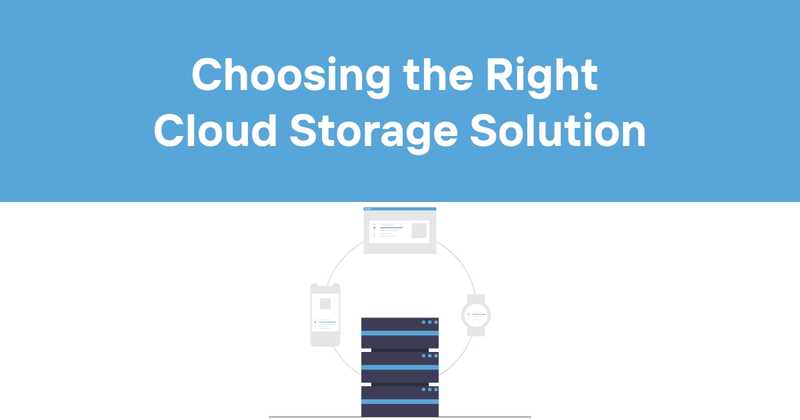Choosing the Right Cloud Storage Solution
Cloud storage has become an integral part of our digital lives, revolutionizing how we store, access, and share data. But what exactly is cloud storage, and why has it become so ubiquitous? Let's embark on a journey through the clouds (the digital ones, that is) and explore this fascinating technology.
Table of Contents
- What is Cloud Storage?
- Types of Cloud Storage
- How Cloud Storage Works
- Benefits of Cloud Storage
- Challenges and Considerations
- Popular Cloud Storage Providers
- Cloud Storage vs. Traditional Storage
- Security in Cloud Storage
- The Future of Cloud Storage
- Choosing the Right Cloud Storage Solution
- Monitoring Cloud Storage Performance
What is Cloud Storage?
Cloud storage is a model of data storage where digital data is stored in logical pools across multiple servers, often in different locations. These servers are typically owned and managed by hosting companies called cloud storage providers.
But let's break it down a bit. Imagine you have a magical box. You can put anything in this box - photos, documents, videos, whatever. Now, instead of keeping this box in your house, you give it to a company that has a massive warehouse full of similar boxes from other people. Whenever you want something from your box, you just ask, and they immediately give it to you, no matter where you are. That's essentially what cloud storage is!
The "cloud" part might make you think of fluffy white things in the sky, but it's really just a fancy term for the internet. When something is stored "in the cloud," it means it's stored on internet-connected servers rather than on your personal device.
Types of Cloud Storage
There are several types of cloud storage, each with its own characteristics and use cases. Let's take a look at the main ones:
-
Public Cloud Storage: This is the most common type. It's like renting a locker in a public storage facility. The provider owns and manages all the infrastructure, and you share the space with other users. Examples include Google Drive, Dropbox, and iCloud.
-
Private Cloud Storage: Think of this as having your own personal storage unit. It's dedicated to a single organization and can be managed internally or by a third party. It offers more control and potentially better security, but it's typically more expensive.
-
Hybrid Cloud Storage: This is a mix of public and private cloud storage. It's like having both a public locker and a private storage unit, allowing you to keep sensitive data in-house while leveraging the scalability of public clouds for less critical data.
-
Personal Cloud Storage: This is for individual users. It's like having a personal server at home that you can access from anywhere. Products like Western Digital's My Cloud fall into this category.
Each type has its pros and cons, and the choice depends on factors like security needs, budget, and scalability requirements.
How Cloud Storage Works
Now, let's get a bit technical (but not too much, I promise). Cloud storage works on a distributed system, spreading your data across multiple servers. Here's a simplified step-by-step process:
-
Data Upload: When you upload a file, it's sent over the internet to the cloud storage provider's data center.
-
Data Processing: The file is processed and potentially broken into smaller chunks.
-
Distribution: These chunks are distributed across multiple servers, often in different locations. This is for redundancy and faster access.
-
Metadata Creation: Information about your file (like its name, size, and location) is stored as metadata.
-
Synchronization: If you make changes to the file, these changes are synchronized across all copies.
-
Access: When you request the file, the system uses the metadata to quickly locate and reassemble all the pieces, sending it back to you.
This process happens so quickly that you probably don't even notice it. It's like ordering a pizza - you don't need to know how it's made or delivered, you just enjoy it when it arrives!
Benefits of Cloud Storage
Cloud storage isn't just a trendy tech thing - it offers some serious advantages:
-
Accessibility: Your data is available from anywhere with an internet connection. No more "Oh no, I left that file at home!"
-
Scalability: Need more storage? Just upgrade your plan. No need to buy new hardware.
-
Cost-Effective: You only pay for what you use, and you save on hardware and maintenance costs.
-
Automatic Backups: Many cloud storage services automatically back up your data, protecting against loss.
-
Collaboration: Easily share files and work on them simultaneously with others.
-
Disaster Recovery: If your local devices are damaged or lost, your data in the cloud remains safe.
-
Syncing: Changes made on one device are automatically reflected on all your devices.
These benefits have made cloud storage an essential tool for both individuals and businesses. It's like having a super-powered filing cabinet that follows you everywhere!
Challenges and Considerations
While cloud storage is awesome, it's not without its challenges. Here are a few things to keep in mind:
-
Internet Dependency: No internet? No access to your cloud-stored files.
-
Security Concerns: Your data is in someone else's hands. While providers take security seriously, breaches can happen.
-
Privacy Issues: Some worry about providers accessing or sharing their data.
-
Costs: While often cost-effective, heavy usage can lead to significant expenses.
-
Performance: Large files or slow internet connections can result in sluggish performance.
-
Vendor Lock-in: Switching providers can be difficult once you've stored a lot of data with one.
-
Compliance: Some industries have strict regulations about data storage and handling.
It's like renting an apartment instead of owning a house. There are great benefits, but you're also subject to the landlord's rules and the building's limitations.
Popular Cloud Storage Providers
The cloud storage market is pretty crowded, but a few big players stand out:
-
Google Drive: Known for its seamless integration with Google's productivity suite.
-
Dropbox: One of the pioneers in cloud storage, known for its simplicity and cross-platform support.
-
Microsoft OneDrive: Tightly integrated with Windows and Office.
-
Apple iCloud: The go-to for Apple users, seamlessly syncing across Apple devices.
-
Amazon S3: More for businesses and developers, offering robust and scalable storage solutions.
-
Box: Popular in the business world, with a focus on security and collaboration.
Each of these has its strengths and weaknesses. It's like choosing a car - the best choice depends on your specific needs and preferences.
Cloud Storage vs. Traditional Storage
Let's have a little face-off between cloud storage and traditional storage methods:
| Feature | Cloud Storage | Traditional Storage |
|---|---|---|
| Accessibility | From anywhere with internet | Only from local device |
| Scalability | Easy to scale up or down | Limited by physical hardware |
| Cost | Pay-as-you-go model | Upfront hardware costs |
| Maintenance | Handled by provider | User responsible |
| Collaboration | Easy file sharing and collaboration | More difficult to share and collaborate |
| Backup | Often automatic | Manual process |
| Security | Provider responsible (but user plays a role) | User fully responsible |
As you can see, cloud storage offers some significant advantages, especially in terms of accessibility and scalability. But traditional storage still has its place, particularly for sensitive data or in situations where internet connectivity is unreliable.
Security in Cloud Storage
Security is a hot topic in cloud storage, and for good reason. You're essentially trusting someone else with your data. Here are some key security aspects:
-
Encryption: Most providers encrypt data both in transit and at rest. It's like sending your data in a locked box that only you have the key to.
-
Authentication: Strong password policies and two-factor authentication help ensure only authorized users can access the data.
-
Access Controls: You can usually set permissions for who can view or edit specific files or folders.
-
Compliance: Many providers offer compliance with various regulatory standards like GDPR, HIPAA, etc.
-
Physical Security: Cloud providers typically have robust physical security at their data centers.
-
Regular Audits: Many providers undergo regular security audits and certifications.
While providers do a lot to keep your data safe, users also play a crucial role. It's like having a high-tech security system in your house - it's great, but you still need to remember to lock the door!
The Future of Cloud Storage
The cloud storage landscape is constantly evolving. Here are some trends to watch:
-
AI Integration: AI could help in organizing and searching through vast amounts of stored data.
-
Edge Computing: This could lead to faster access to cloud-stored data by bringing storage closer to the user.
-
Blockchain: Some are exploring how blockchain could enhance security and privacy in cloud storage.
-
Quantum Computing: While still in its infancy, quantum computing could revolutionize data processing and storage.
-
Green Storage: As data centers consume a lot of energy, there's a push towards more environmentally friendly storage solutions.
The future of cloud storage looks exciting. It's like we're at the beginning of a new chapter in the book of data storage!
Choosing the Right Cloud Storage Solution
Selecting the right cloud storage solution can be daunting. Here are some factors to consider:
-
Storage Capacity: How much data do you need to store?
-
Pricing: What's your budget? Remember to consider long-term costs.
-
Security Features: What level of security do you need?
-
Ease of Use: Is the interface user-friendly?
-
Integration: Does it work well with your existing tools and workflows?
-
Collaboration Features: Do you need to share files and work with others?
-
Mobile Access: Do you need robust mobile apps?
-
Customer Support: What kind of support does the provider offer?
Take your time to evaluate different options. It's like choosing a new home - you want to make sure it fits all your needs before moving in!
Monitoring Cloud Storage Performance
Once you've chosen a cloud storage solution, it's crucial to monitor its performance. This is where tools like Odown come into play. Odown offers robust monitoring capabilities that can help ensure your cloud storage is always accessible and performing optimally.
With Odown, you can:
- Monitor the uptime of your cloud storage services
- Set up alerts for any performance issues
- Track response times to ensure quick access to your data
- Monitor SSL certificates to maintain secure connections
By using a tool like Odown, you can stay on top of your cloud storage performance, ensuring that your data is always available when you need it. It's like having a personal assistant constantly checking that everything's running smoothly!
In conclusion, cloud storage has transformed how we store and access data. It offers unprecedented flexibility, scalability, and collaboration opportunities. However, it also comes with its own set of challenges and considerations. By understanding the landscape of cloud storage and utilizing tools like Odown for monitoring, you can make the most of this powerful technology. So go ahead, embrace the cloud - your data will thank you!



